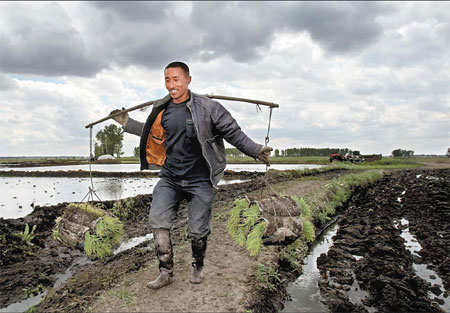On a routine stroll in her 11.2 hectares of cornfields one recent morning, farmer Cui Shulan heaved a sigh of relief. This year, she will get a bumper crop of corn.
 |
|
A farmer carries rice seedlings in Yushu, Jilin province, in May. Many farmers have turned their land into paddy fields in the wake of rising rice prices. File photo
|
"Nature has treated us kindly this year," said the 61-year-old farmer from Dongling village in Jilin province. "We've had ample sunshine and adequate rainfall. If all goes well, we could get a yield of 17,500 kg in the fall."
Like millions of small farmers who eke out a living on small patches of land, Cui's fortunes are dependent on Mother Nature.
"Crop plantation in Jilin is still at the mercy of weather," Cui said simply. "One year we have a bumper harvest, while another very poor one."
Despite being the world's largest agricultural country with the bulk of its population - 56 percent - in rural areas, China's farming practices have changed very little throughout the centuries. The country's rapid urbanization and economic growth in the last few decades have only widened the gap between the rural and urban economies.
The increasing gap in income between city and country has prompted the central government to focus more attention on rural areas, and on agricultural development.
This is especially important for a province like Jilin, which is home to one of the world's top three corn production belts, the other two being in the United States and Ukraine.
In Jilin, the main factor that has hampered agricultural development is lack of water due to a poor farmland irrigation system. Although the province has had good crop yields for five consecutive years, it is still beset by frequent natural disasters.
"We can raise our grain production capacity if we can improve water conservation," said Su Zheng of the water resources department of the Jilin province.
Cui, whose village on the edge of the Songnen plain is one of the country's major corn producers, agreed: "Without a good water conservancy project, droughts and floods still threaten our crops every year. Due to a severe drought last year, our yield was only a little more than 11,500 kg."
Most of the villagers rely on well water. The well water, Cui said, was "only enough for drinking and our daily use. Other than praying for rain, we could do nothing to relieve the drought."
The central government has increased its investments in construction of farmland irrigation in recent years, but they have mainly been for projects along major rivers, large reservoirs and for flood control in urban areas, according to Su of the Water Resources Department. Little of the money has trickled down to small and medium sized systems, he added.
Most of the irrigation systems in Jilin province were constructed some 40 to 50 years ago, and all have leaks, Su said. No money has been invested in the province's 135 medium-sized irrigation systems since then.